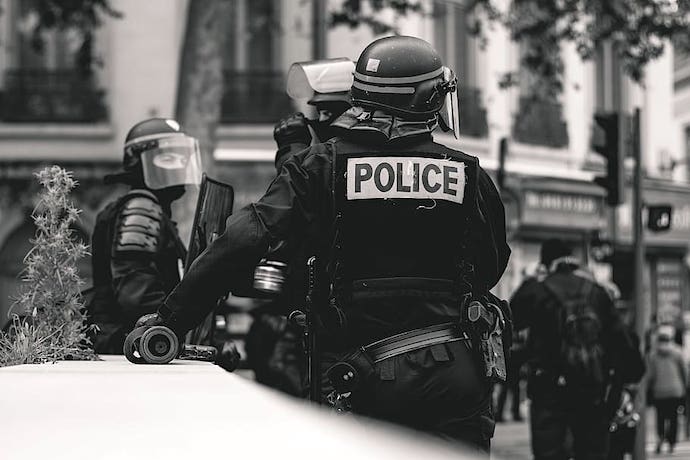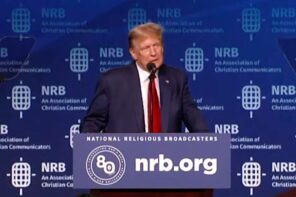Recently, the Biden administration released the U.S. National Strategy to Combat Antisemitism, an unprecedented report advancing a broad policy agenda to combat, as its name suggests, antisemitism.
As researchers who study antisemitism and Islamophobia on the Right, we were encouraged that the report framed these oppressions within the broader upsurge in White supremacist violence that has targeted so many communities in recent years, and spoke compellingly of the connections between forms of oppression. We were discouraged, however, that some of the White House’s policy proposals cut against the intersectional approach we need, leaving the door open to flawed strategies—such as suppressing Israel-critical speech and expanding the police and security state—that harm Muslim and other communities, and ultimately do little to keep Jews safe.
In the lead-up to the release of the report, public controversy hinged on whether the White House would adopt the International Holocaust Remembrance Alliance (IHRA) definition of antisemitism crafted in the early 2000s and largely ignored for a decade.
As IHRA’s lead drafter has maintained, the definition was never meant to be a legislative tool. Since the mid-2010s, however, the IHRA definition has been at the core of a legislative and public relations strategy advanced by the Israeli government, and pro-Israel organizations on the Right and Center to suppress criticism of Zionism and, in particular, of Israel’s oppression of Palestinians. The IHRA, in short, provides cover for those who indiscriminately label a wide range of criticism of Israel as antisemitic.
Indeed, over 1,000 institutions worldwide, including governments, universities and NGOs have adopted the IHRA definition, advancing laws, resolutions and policies that effectively penalize and discourage criticism of Israel and Zionism and tactics such as boycott, divestment and sanctions intended to hold Israel accountable. Advanced with special vigor during the Trump administration, these unconstitutional attacks on freedom of speech have been passed in at least 31 states in the U.S. and inspired copycat efforts by the fossil fuel industry and gun lobby.
It’s encouraging that the White House strategy only mentions the IHRA definition in passing, presenting it as one “non-legally binding” approach alongside better definitions of antisemitism, and devotes relatively little space to the false conflation of Palestine solidarity activism with antisemitism. This falls far short of the full-throated adoption of IHRA that Israel advocacy orgs like the Anti-Defamation League had been lobbying for, and, as commentators have noted, it’s a significant improvement over a similar report from the European Union, in which IHRA plays a much more central role. However, the White House report still “embraces” IHRA, signaling that the flawed definition may still be utilized to shape policy responses.
The report affirms Americans’ First Amendment right to free speech, but it still repeats the tired script about Israel being “singled out” on college campuses and Jewish students and educators being “targeted” for their support for Israel—blanket assertions that in many contexts are used as a pretext to suppress Palestine solidarity organizing.
Countering Violent Extremism to counter ‘hate’
Encouragingly, the report uplifts the interconnectedness between antisemitism, Islamophobia and other forms of oppression and calls for “cross-community solidarity and collective action.” However, by continuing to “embrace” IHRA and prioritizing harmful CVE-based approaches to combating antisemitism, the recommendations undercut this recognition, bolstering approaches that foment Islamophobia and other bigotry.
On September 15, 2022, President Biden hosted the United We Stand Summit at the White House to announce new strategies and funding to counter violence, extremism, and “hate.” While many activists and communities welcomed this news, the announcement used vocabulary that has been historically utilized by DHS and other law enforcement agencies to justify the surveillance and policing of “suspect” communities. Progressive organizations and activists have pushed back on the White House’s tendency to use methods based on debunked political science theories and the historical discrimination against communities disproportionately targeted in the War on Terror.
The White House, Department of Homeland Security, Federal Bureau of Investigation, and many other law enforcement agencies, however, have claimed that these are the necessary programs to counter domestic extremism and terrorism—particularly White supremacist violence. While these programs claim they focus on White supremacist and far-right violence, they use vague terminology such as “racially motivated violent extremism” or “domestic violent extremism,” giving present and future administrations free rein to surveil any social or political movement or ideology that fits the label.
Unsurprisingly, these terms have mainly targeted Black and Muslim communities, along with pro-abortion activists, pro-Palestine activists, and their allies. Programs claiming to target far-right violence and White supremacy are frequently weaponized by law enforcement agencies against progressive activists and historically oppressed communities. Bolstering one form of oppression to combat another isn’t merely morally compromised—it’s also counterproductive. Since these systems of oppression are inextricably connected, any move that feeds into one, inevitably fuels the other.
The White House claims widespread civil society support for these measures to justify perpetuating these programs intended to combat antisemitism and increase cross-community solidarity. Halfway through the report, the White House emphasizes its dedication to the Targeted Violence and Terrorism Prevention program (TVTP) as a way to combat antisemitism in society and online. That the report was produced in collaboration with over 1000 ‘diverse stakeholders’ gives the impression that CVE/TVTP programs are endorsed by a majority of civil society actors, social movements, and communities. And unfortunately, some ostensibly liberal civil society organizations, like the ADL, continue to support these measures.
Yet the White House admits that these programs have “created trust deficits in key communities”—translation: alienated critical stakeholders and targeted communities—which is important to note as Muslim, Arab, Black, LGBTQ, and disability activists and organizations have consistently spoken about the detrimental effects of these programs on their communities since the Obama administration first launched CVE in 2011. The best way to eradicate a “trust deficit” between these communities and the government is to simply eliminate them and dedicate the resources and funding to programs for social services.
Moving beyond “hate”
If we’re to build a more just and equitable society, we must accept a radical departure from the frameworks and methods that have neither prevented the proliferation of Islamophobia, antisemitism, and other forms of oppression, nor ensured the well being of vulnerable communities in the process.
Like most mainstream discourse, the report essentializes antisemitism as ‘the world’s oldest hatred,’ collapsing 2,000 years of complicated history into what historians have called an eternalist framework, one that elides differences and specificities in cultural and historical context. Similarly, “hate” is an abstract term used to obscure the structural, cultural, and institutional violence marginalized communities experience—including antisemitism.
In a moment when the Right relentlessly attacks critical race theory and trans people, the report’s emphasis on the need for education on antisemitism and other forms of oppression is a positive development. Tellingly, however, the report fails to mention these attacks or their broader context. When CRT, ethnic studies and area studies are being defunded, and books are being banned in Florida and across the country, antisemitism education initiatives are undercut as well, since antisemitism is connected to these other forms of oppression. Without this broader field, antisemitism risks being taught in an exceptionalized and depoliticized way that ironically undercuts broader efforts to eradicate antisemitism—as well as oppression in all its forms.
Finally, there are more effective ways to ensure that Jewish communities and other marginalized communities are safe: uplifting community safety programs that don’t rely on law enforcement or incarceration processes; increasing access to mental health services through more funding; and diverting money from militarized law enforcement to communities, to name a few. Increasing Jewish communities’ collaboration with law enforcement won’t combat the root causes of antisemitism or other forms of discrimination, and CVE/TVTP programs will only be weaponized to target Muslim communities, those struggling with mental health issues, active community members, and vocal progressive activists.
In a social and political moment where access to resources are being cut and limited at every level of government, investing in the “security” and counter-extremism industry will only harm the communities most likely to experience far-right violence in the first place. More law enforcement and surveillance to address endemic systemic discrimination and a shortage of social services (such as education) undermine both goals. In the struggle towards just and inclusionary democracy, investing in communities rather than policing them is the path to safety.





